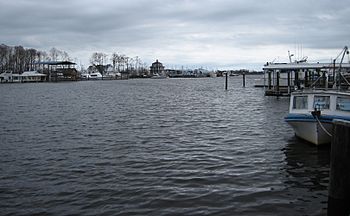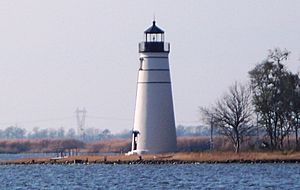Tchefuncte River facts for kids
Quick facts for kids Tchefuncte River |
|
|---|---|

Tchefuncte River as seen at Madisonville
|
|
| Country | United States |
| State | Louisiana |
| Parishes | Washington, Tangipahoa, St. Tammany |
| Cities | Covington, Madisonville |
| Physical characteristics | |
| Main source | Tangipahoa Parish, Louisiana 30°54′22″N 90°20′59″W / 30.90611°N 90.34972°W |
| River mouth | Lake Pontchartrain Madisonville, St. Tammany Parish, Louisiana 30°22′36″N 90°09′38″W / 30.37667°N 90.16056°W |
| Length | 70 mi (110 km) |
| Basin features | |
| Tributaries |
|
| GNIS number | 1628339 |
The Tchefuncte River ( chə-FUNK-tə) flows into Lake Pontchartrain in Louisiana, United States. It is about 70 miles (110 km) long.
Contents
What's in a Name? The Tchefuncte River's Meaning
The name Tchefuncte comes from the Choctaw word Hachofakti. This word means "American chinquapin," which is a type of chestnut tree. Native Americans used parts of this tree to help with headaches and fevers.
Ancient People of the Tchefuncte River
Long ago, around 600 BCE, a group of hunter-gatherers called the Tchefuncte culture lived near this river. They were skilled at finding food.
- They gathered fresh-water clams, fish, and crawfish from the river.
- They built large piles of shells, called shell middens, along the riverbanks.
- Their homes were likely simple, round shelters. These were made from light poles covered with natural materials like palmetto leaves, thatch, or grass mixed with mud.
The Tchefuncte River Shipyard and the War of 1812
During the War of 1812, the Tchefuncte River played a small but important role. The U.S. Navy planned to build a special ship here.
- The Secretary of the Navy, William Jones, ordered a ship to be built at a shipyard in Madisonville, Louisiana.
- This ship was meant to be a "blockship," armed with 32 heavy cannons. It was designed to sail in shallow water.
- Even though Major General Andrew Jackson urged for its completion, the ship was not finished when the Battle of New Orleans began. It stayed at the Madisonville shipyard.

The Historic Tchefuncte River Lighthouse
A very important landmark on the Tchefuncte River is its lighthouse. It has guided ships for many years.
- In 1837, the Tchefuncte River Range Lights lighthouse was built. Its job was to help ships find their way across Lake Pontchartrain to the river's mouth.
- The lighthouse used nine lamps and several large reflectors to create its light.
- It was damaged during the Civil War but was repaired in 1867.
- In 1939, the U.S. Coast Guard took over the lighthouse. They updated it with an electrical system.
- The town of Madisonville took ownership in 1999 and worked to restore this historic building.
- The lighthouse bravely survived Hurricane Katrina and Rita. It remains a key historical site today.
The River's Journey: Course of the Tchefuncte
The Tchefuncte River starts its journey in northeastern Tangipahoa Parish.
- It first flows south, forming part of the border for Tangipahoa, Washington, and St. Tammany Parishes.
- Then, it turns southeast into St. Tammany Parish. Here, it flows past the city of Covington and the town of Madisonville.
- Near Covington, it meets its largest branch, the Bogue Falaya.
- Finally, the Tchefuncte River flows into Lake Pontchartrain, about 2 miles (3.2 km) south of Madisonville.
The state of Louisiana has named the Tchefuncte a "Natural and Scenic River." Fairview-Riverside State Park is a beautiful park located along the river, just upstream from Madisonville.

The Tchefuncte River Today
In the 1800s, the Tchefuncte River was a busy waterway for trade.
- Building materials and other goods from the north shore of Lake Pontchartrain were loaded onto boats here.
- These goods were then shipped across the lake to New Orleans.
- Today, the river is still important for recreation and its natural beauty.

